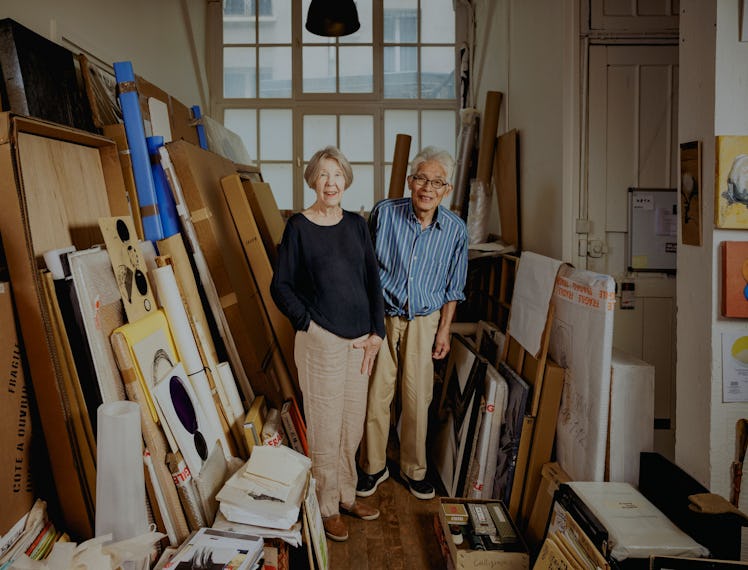A Tale of Two Artists Becomes a Love Story for the Ages
Life partners Takesada Matsutani and Kate Van Houten have a joint show in New York featuring 40 years of work.

Takesada Matsutani and Kate Van Houten, artists and life partners, first met in 1967, over half a century ago, as young artists working at Stanley William Hayter’s celebrated Paris printmaking studio Atelier 17. Matustani was fresh from Japan, where he was one of the youngest members of the avant-garde collective Gutai; Van Houten, an American coming off a stint studying in Italy. There were early sparks, despite the language barrier. Soon after meeting, Van Houten asked Matsutani on their first date, a trip to the cinematheque for a Buster Keaton film.
“He had a little English, no French, and was really very concentrated on his work,” Van Houten tells W in a joint video interview. “His imagery was very, very curious and he seemed extraordinary. So that impressed me deeply. I don’t think I impressed him at all.
“He had nice shoulders and good hands,” she continues. “So what are you going to do?”
From left: Irene Whittome, Isolde Von Gart, Claire Crossley, Matsutani,Van Houten, Jean Lodge, and Dupak Benargis, 1968.
Matsutani and Van Houten’s long personal and professional relationship is now being celebrated with a show at Hauser & Wirth’s 18th Street location in New York City, simply titled “Paris Prints 1967-1978.” The exhibition, divided into two “chapters” (the first a show of etchings and intaglio printmaking, running till March 9th; the second featuring hard-edged silkscreens, from March 12th to April 20th), is dedicated to what the gallery calls a “creative dialogue” between the artists.
They have been in dialogue, figuratively and literally, for years now—during the window of time covered by the show, the two were working together at a combination of Atelier 17 and Van Houten’s own independent studio (Matsutani continued working for Hayter after Van Houten left his shop, the two workspaces inspiring him to combine multiple mediums on one page).
“I saw the power of Matsutani’s etchings in particular,” says Anders Bergstrom, director of Hauser & Wirth Editions, who put the “Paris Prints” show together. “Visiting his studio in Paris, spending time with him and Kate, looking at their bodies of work together, talking about techniques and their histories—I realized their work is in conversation, in life and love and in their appreciation of printmaking.”
Takesada Matsutani, La propagation-10, 1967.
Kate Van Houten, Detail of Apparatus, 1970.
That shared love for printmaking comes through when speaking to the couple. “The process of making a print with etching and engraving, it’s an alchemy,” Van Houten says. “It’s a mystery. And the mystery is only revealed in the process.”
“It’s like a volcano,” Matsutani adds. “Suddenly, boom! There’s no logic.”
“Beauty should be a surprise,” Van Houten continues. “Matsutani would use this example: take a piece of paper, white paper, nothing’s on it. Make a mark, and you’ve changed everything.”
Matsutani—known for his work with unorthodox materials like glue, experiments with the color black, and renderings of sensuous forms that recall the female body—found printmaking to be a jolt to his artistic practice. “I worked so much [at that time], and I was so involved in my engraving,” he says. “My images were three-dimensional, a kind of object. I wanted to do flat things, so I learned printing technique.”
Both repeatedly reference their respect for Hayter, who ran a studio with one major rule: no politics or religion. It worked—during that tense time in Paris, the May 1968 student protests looming, Atelier 17 employed numerous women, treating them as equals without making a fuss about it.
“I had finished studying at Accademia di Brera in Milano,” recalls Van Houten. “And one reason I left Italy was it was just too much uphill. I was always the mascot at the studios, this cute American girl fiddling around, and nobody was going to take me seriously. So I thought, ‘Time to leave. I will go through Paris.’ And when I got there, I said, ‘This is marvelous.’
“At the Atelier 17 with Bill Hayter, I realized I had returned to something that I knew a little bit about in America,” she adds. “It had already started, women claiming their terrain, challenging an environment and a world.” Her prints from this period are vibrant and dizzying, with playful titles like Break Up I. Her works flow together with Matsutani’s when paired on the gallery wall, yet also stand apart from each other. As Olivier Renaud-Clément, an art dealer and advisor to Matsutani, describes it, “we can see similarities in both series of work, but also very different ways of working. Kate seems to have a big sense of movement and velocity, where Matsutani is much more at a stop.”
A look at the “Takesada Matsutani / Kate Van Houten. Paris Prints 1967-1978,” exhibition at Hauser & Wirth on 18th Street in New York City.
When asked what they learn from each other artistically, Matsutani and Van Houten, for all their genius, are slightly stumped—the question is simply too big. “It’s an exchange all the time,” Van Houten offers. “We still have things to talk about: art or artists, philosophy. And we stay up much too late often, just talking.”
Takesada Matsutani and Kate Van Houten, Do You Dance, 2024.
It’s Valentine’s Day, and here, the longtime couple presents an original Valentine. They also gave me some pragmatic romantic advice. “In this couple, between us, I think we’ve learned to deeply respect each other’s autonomy,” Van Houten says.
“Well, I’m not free sometimes,” Matsutani replies.
“Nobody is, come on,” Van Houten says. “But in a couple, I believe you have to accept that you’ll never know everything. You can certainly still enjoy that person.” And enjoy their artistic contributions—it seems to have worked for 57 years. Happy Valentine’s Day.